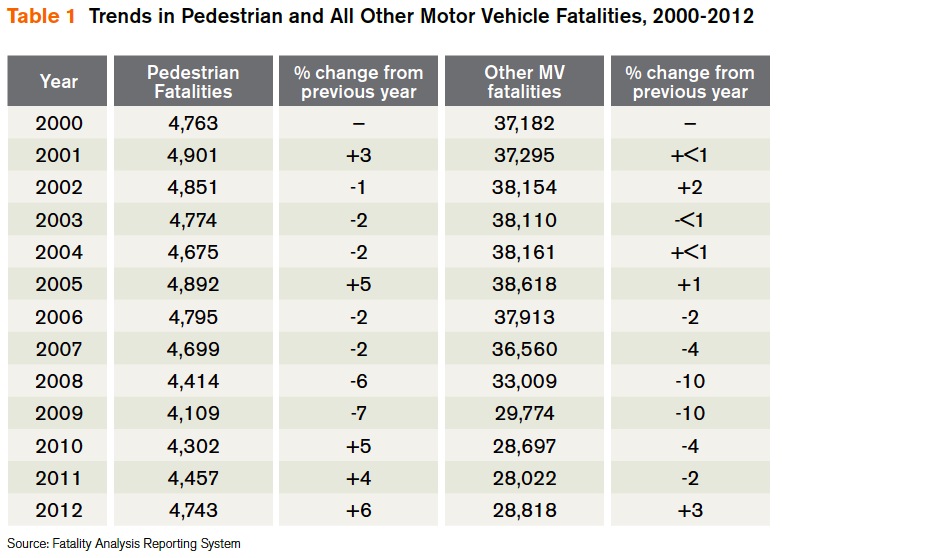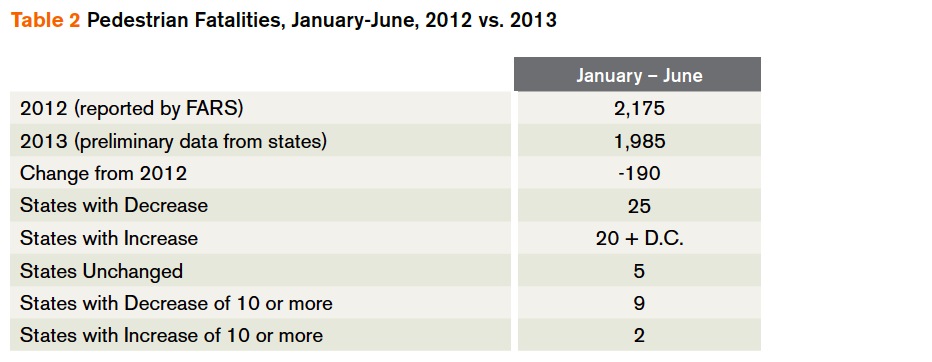GOVERNORS HIGHWAY SAFETY ASSOCIATION
Introduction
Public roads are designed primarily to accommodate motor vehicle travel. People on
foot also use these roads, crossing or traveling on or alongside them. Collisions involving
pedestrians and motor vehicles can have serious consequences. Pedestrians, along with
bicyclists and motorcyclists, are commonly referred to as “vulnerable road users”: when
they collide with motor vehicles the lack of a protective structure and differences in
mass heighten their susceptibility to injury. Worldwide, pedestrians comprise 22% of the
1.24 million yearly traffic deaths, with especially high contributions in low- and middleincome
countries that are becoming motorized (World Health Organization, 2013).
Pedestrians on the road network are thus at risk. At the same time, walking and
bicycling are encouraged by many organizations for health and environmental reasons.
Physical activity is a means to combat obesity and reduce greenhouse gas emissions.
The Fatality Analysis Reporting System (FARS) includes data on deaths involving
pedestrians when the crash originates on a public roadway. Crashes that occur
exclusively on private property, including driveways and parking lots, are not included.
In 1975, the first year in which data from the Fatality Analysis Reporting System
(FARS) were compiled, there were 7,516 pedestrian deaths. This number has dropped
significantly since then.
Trends in pedestrian deaths and in all other motor vehicle deaths from 2000 through
2012 and year-to-year fluctuations are displayed in Table 1. Between 2005 and 2009
pedestrian deaths declined from 4,892 to 4,109, but subsequently increased. The first
indication that the downward trend had halted was detailed in a 2011 report by the
Governors Highway Safety Association (GHSA). There were 4,302 pedestrian deaths in
2010, increasing to 4,457 in 2011 and 4,743 in 2012. The uptick in pedestrian deaths in
2010 and 2011 stood out because other motor vehicle deaths were declining in those
years. Notably, pedestrian deaths in 2012 were still lower than in all but one of the years
from 2000 through 2006.
Concerns about the possibility of further increases prompted GHSA to conduct this new
study of pedestrian deaths in the first six months of 2013, based on preliminary counts
provided by State Highway Safety Offices (SHSO) in October/November 2013. This is
the same methodology used in the prior study of 2010 pedestrian deaths, in which 1,891
fatalities were reported by the states for the first six months of the year. This compares with
the 1,906 deaths subsequently reported by FARS for this same time period, making the
preliminary counts quite accurate.
All 50 states and the District of Columbia provided preliminary data for the first six months
of 2013. States also were asked to comment on any trends in their data, the extent to which
distraction is a factor in pedestrian deaths, and programs that are in operation or being
planned to address pedestrian safety.


Download full version (PDF): Pedestrian Fatalities By State
About the Governors Highway Safety Association
www.ghsa.org
GHSA is a 501(c)(3) nonprofit representing the state and territorial highway safety offices that implement programs to address behavioral highway safety issues.
Tags: GHSA, Governors Highway Safety Association, Pedestrian, safety






 RSS Feed
RSS Feed